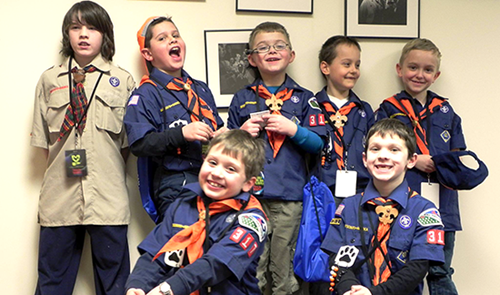EASTON, PA—On April 9, seven Cub Scouts, along with their siblings and parents, visited Suntex International Inc., the parent company of First In Math, to learn that creating a digital game follows a lot of the same simple steps they use to build Lego® figures, write a story, or play an instrument.

“Scouting is about the boys learning life skills, trying new things, and gaining confidence in themselves and their abilities,” explains Troop Leader Stacey Smith. During the field trip—referred to as a GO SEE IT—the boys learned about Internet communications, how important math is in creating digital games, and how they already practice the steps to making a digital game each time they create something.
The visit started at the Kitchen table—where many of First In Math’s good ideas and conversations start! First, the boys considered the steps necessary to create a game. Their five steps were: brainstorm ideas; make a rough copy; make a better copy; test (then test some more) and implement the final product.
After discussing why each of these steps is important anytime something is created, scouts toured the office to see how each staff member works through the steps.
The boys visited the Art Director’s office, talked with the Implementation Specialists—even met the Inventor of First In Math, Robert Sun—but none of these was their favorite. That distinction went to one of the FIM game developers (and it wasn’t just because he has the same Minecraft posters on his wall as some of the scouts do on theirs).
“The boys were able to see code in action. They saw how changes to specific codes changed specific areas of the First In Math site, and were able to write their own temporary messages on the site,” says FIM Implementation Specialist Shawn Collier.
FIM web developer Casey Rule told the boys how important it is to work as a group regarding the five steps they identified. “While each of us brainstorm, draft, test, and complete projects individually when making a game we need to also do this as a team,” says Rule.
During the hour-long visit to First In Math, the scouts from Den 2 learned that creating a digital game isn’t only about learning to write code. They learned that the skills they are using (both personally and academically) as scouts, writers, musicians—and Minecrafters—all affect their ability to create a digital game one day.
“The truth is that the tools these boys will use as adults to create future video games haven’t even been created yet, but the skills they need master those tools haven’t changed in thousands of years,” says Collier. “Today, hopefully, these scouts learned that the ability to think, plan, problem solve, and communicate are necessary no matter what they choose to do.”
In a complicated, sometimes confusing, world of standards-driven education there is a beauty in identifying what has always helped human beings move forward—the ability to create. So, to all the Boys Scouts and Girl Scouts out there—CREATE! Create a song, create a video game, create a masterpiece!
-----------------
EDITOR’S NOTE: Troops organize Go See It outings to reinforce the Tiger Cub motto of Search, Discover, Share. According to the Boy Scouts of America website, these experiences provide an opportunity for scouts and parents to acquire new interests and knowledge, develop a deeper understanding of and respect for other people, reinforce their attitudes of good citizenships, and, of course, have fun.